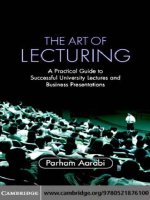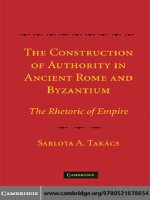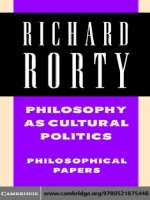cambridge university press stone vessels and values in the bronze age mediterranean aug 2007 kho tài liệu bách khoa
Bạn đang xem bản rút gọn của tài liệu. Xem và tải ngay bản đầy đủ của tài liệu tại đây (6.96 MB, 315 trang )
P1: JZP
cufx140main
CUFX140-Bevan
0 521 88080 0
July 16, 2007
This page intentionally left blank
ii
7:45
P1: JZP
cufx140main
CUFX140-Bevan
0 521 88080 0
July 16, 2007
Stone Vessels and Values in the
Bronze Age Mediterranean
The societies that developed in the eastern Mediterranean during the Bronze Age produced
the most prolific and diverse range of stone vessel traditions known at any time or anywhere
in the world. Stone vessels are therefore a key class of artefact in the early history of this
region. As a form of archaeological evidence, they offer important analytical advantages over
other artefact types – virtual indestructibility, a wide range of functions and values, huge
variety in manufacturing traditions, as well as the subtractive character of stone and its rich
potential for geological provenancing. Stone also has wide anthropological and archaeological
relevance. It offers a favourable vantage from which to consider concepts of object value
and how these might be approached in the archaeological record. In this book, Andrew
Bevan considers individual stone vessel industries in great detail. He also offers a highly
comparative and value-led perspective on production, consumption, and exchange logics
throughout the eastern Mediterranean over a period of two millennia during the Bronze Age
(ca. 3000–1200 BC).
Andrew Bevan is a lecturer at the Institute of Archaeology, University College London. His
work has been supported by fellowships from the Leverhulme Trust, the Institute of Aegean
Prehistory, and the Dr. M. Alwyn Cotton Foundation. He also received the Michael Ventris
Memorial Award for Mycenaean Studies.
i
7:45
P1: JZP
cufx140main
CUFX140-Bevan
0 521 88080 0
July 16, 2007
ii
7:45
P1: JZP
cufx140main
CUFX140-Bevan
0 521 88080 0
July 16, 2007
Stone Vessels
and Values in the
Bronze Age Mediterranean
ttt
Andrew Bevan
university college london, institute of archaeology
iii
7:45
CAMBRIDGE UNIVERSITY PRESS
Cambridge, New York, Melbourne, Madrid, Cape Town, Singapore, São Paulo
Cambridge University Press
The Edinburgh Building, Cambridge CB2 8RU, UK
Published in the United States of America by Cambridge University Press, New York
www.cambridge.org
Information on this title: www.cambridge.org/9780521880800
© Andrew Bevan 2007
This publication is in copyright. Subject to statutory exception and to the provision of
relevant collective licensing agreements, no reproduction of any part may take place
without the written permission of Cambridge University Press.
First published in print format 2007
eBook (NetLibrary)
ISBN-13 978-0-511-33540-2
ISBN-10 0-511-33540-7
eBook (NetLibrary)
ISBN-13
ISBN-10
hardback
978-0-521-88080-0
hardback
0-521-88080-7
Cambridge University Press has no responsibility for the persistence or accuracy of urls
for external or third-party internet websites referred to in this publication, and does not
guarantee that any content on such websites is, or will remain, accurate or appropriate.
P1: JZP
cufx140main
CUFX140-Bevan
0 521 88080 0
July 16, 2007
For my parents
v
7:45
P1: JZP
cufx140main
CUFX140-Bevan
0 521 88080 0
July 16, 2007
vi
7:45
P1: JZP
cufx140main
CUFX140-Bevan
0 521 88080 0
July 16, 2007
Contents
Acknowledgments r page x
tttttt
1 / Introduction
1
3
6
Comparative Terminology
Chapter Summary
2 / Agreeing on Things
8
10
12
16
Classification and Transmission
Social Relationships
Wealth Measurement
3 / Moving People, Objects, and Ideas
19
19
21
23
26
29
30
32
35
38
Moving Around the Eastern Mediterranean
Bronze Age Economies and Exchanges
Behind Bronze Age Gifts
Scale in the Archaeological Record
Merchants and Their Roles
Third Millennium Trade
Earlier Second Millennium Trade
Later Second Millennium Trade
Summary
4 / Making Stone Vessels
40
40
41
43
43
44
45
47
50
52
54
54
55
56
56
57
60
The Working Properties of Stones
Unassisted Manual Abrasion
Carving
Pounding and Sawing
Drilling
Cutting Technologies
Drill-Bit Driving Technologies
Drilling Strategies
A Template Production Sequence
Bronze Age Production Traditions
Egypt
The Levant
Cyprus
Anatolia
The Aegean
Conclusion
5 / The Third Millennium
Egypt
The Pre-Third Millennium Background
vii
62
62
62
7:45
P1: JZP
cufx140main
CUFX140-Bevan
0 521 88080 0
July 16, 2007
contents
viii
Early Dynastic and Earlier Old Kingdom
Later Old Kingdom and the First Intermediate Period
The Levant
The Pre-Third Millennium Background
Egyptian Vessels
Non-Egyptian Vessels
Cyprus and Central Anatolia
The Aegean
The Pre-Third Millennium Background
The Grotta-Pelos Phase
The Keros-Syros Phase
EMIIA Crete
Later Prepalatial Crete
Trade Beyond Crete
6 / The Earlier Second Millennium
Egypt
The Middle Kingdom
The Second Intermediate Period and Early 18th Dynasty
The Levant
Egyptian-Style Vessels
Levantine Vessels
Anatolia
The Aegean
Protopalatial Crete
The Neopalatial Period
7 / The Later Second Millennium
Egypt
The Mid-18th Dynasty
The Amarna Age
The 19th Dynasty
The Levant
Egyptian-Style Vessels
Southern Levantine Gypsum Vessels
Cyprus
Egyptian-Style Vessels
Local Cypriot Vessels
Anatolia
The Aegean
Egyptian, Cypriot, and Levantine Vessels
LMII-III Knossos
Mycenae Ivory Houses-Style Vessels
63
72
75
75
76
78
79
80
80
80
83
85
86
93
100
100
100
101
102
102
108
113
115
115
119
134
134
134
138
142
143
143
150
152
152
153
156
157
157
158
163
7:45
P1: JZP
cufx140main
CUFX140-Bevan
0 521 88080 0
July 16, 2007
contents
8 / The Rough and the Smooth: Stone Vessels from a Comparative
Perspective
Stone Vessels in Small-Scale Societies
Softstone Industries
Light-Coloured Softstones
Dark-Coloured Softstones
Complex Stone Vessel Traditions
9 / Forging Value and Casting Stones
After the Bronze Age
Vessels and Values
Future Directions
Appendix: Typological Guide
tttttt
Bibliography r 259
Index r 293
166
168
169
170
172
179
185
185
186
192
195
195
211
214
223
229
232
241
244
Egypt (E-)
Egyptian-Style (Es-)
Levant (L-)
Cyprus (Cyp-)
Anatolia (A-)
Crete (C-)
Mycenaean-Style Vessels (M-)
Cyclades (Cyc-)
Notes r 251
ix
7:45
P1: JZP
cufx140main
CUFX140-Bevan
0 521 88080 0
July 16, 2007
Acknowledgments
tttttt
This book first began as doctoral research, for which I benefited from generous financial support
from the Arts and Humanities Research Council (then AHRB). During this time, I was
able to conduct fieldwork and attend conferences largely through the further support of
the Institute of Archaeology, the University College London (UCL) Graduate School, and
the British Institute of Archaeology at Ankara, to all of whom I am extremely grateful. A
Leverhulme Trust postdoctoral fellowship, while dedicated to other research goals, allowed
time for me to acquire additional skills and to develop my ideas further. Thereafter, I was able
to devote a crucial year to new research and writing-up with the benefit of an Institute of
Aegean Prehistory fellowship, a Cotton Foundation grant, and a Michael Ventris Memorial
Fund award, all of which led to late insights into particularly thorny problems. The final
stages of writing were challenged and yet also inspired by the demands of full-time teaching
at UCL.
There are numerous people who helped at different stages of this study. I am especially
grateful to the academic and administrative staff and students of the UCL Institute of Archaeology for providing such a friendly and inspiring research environment. Cyprian Broodbank
has been, and still is, a source of endless guidance and encouragement. Todd Whitelaw
has provided help with an array of research and teaching questions, some of which I hope
has made an impact here. Also, many thanks to Alexander Ahrens, Daniel Antoine, Carol
Bell, Lisa Bendall, John Bennet, Elizabeth Bloxham, Stuart Brookes, Tristan Carter, Steffie
Chlouveraki, James Conolly, Jago Cooper, Lindy Crewe, Joanne Cutler, Hel`ene David,
Don Evely, Lesley Fitton, James Harrell, Eleni Hatzaki, Christophe Helmke, David Jeffreys,
Peter Jordan, Evangelia Kiriatzi, Carl Knappett, Olga Krzyszkowska, Lorenzo Lazzarini,
Mark Lake, Borja Legarra, Christine Lilyquist, Kris Lockyear, Christina Luke, Marcos
Martin´on-Torres, Roger Matthews, Nicoletta Momigliano, Orazio Palio, Ian Patterson,
Edgar Peltenburg, Jacke Phillips, Claude Poursat, Laura Preston, Stephen Quirke, Lucinda
Reeves, Thilo Rehren, Brian Robertson, Christopher Roosevelt, Joanne Rowland, Jerry
Rutter, Robert Schaub, Vincent Serneels, Susan Sherratt, Ruth Siddall, Karin Sowada,
Rachael Sparks, Denys Stocks, Geoffrey Tassie, Peter Ucko, Peter Warren, Vance Watrous,
David Wengrow, and the two anonymous Cambridge reviewers for discussing different aspects of the subject with me, providing digital data, reading chapter drafts, or otherwise
contributing to this effort. No doubt there are others who I have omitted for which I offer
my sincere apologies. Any remaining errors are my own responsibility.
Permissions to reproduce photographs and/or include illustrations were kindly supplied
by the following people and institutions (in alphabetical order): the Ashmolean Museum,
Barbara Aston, the British Museum, the British School at Athens, the Cairo Museum,
x
7:45
P1: JZP
cufx140main
CUFX140-Bevan
0 521 88080 0
July 16, 2007
acknowledgments
xi
Pierre de Miroschedji, Christos Doumas, Ebla Expedition, Don Evely, Pat Getz-Gentle,
James Harrell, the Herakleion Museum, the Italian School of Archaeology at Athens, Vassos
Karageorghis, Gernot Katzer, Kay Kohlmeyer, Karla Kroeper, Olga Krzyszkowska, the
Louver Museum, Paolo Matthiae, the Metropolitan Museum of Art, the National Museum
¨ uc¸, Philip von
of Greece, the Oriental Institute at the University of Chicago, Nimet Ozg¨
Zabern Press, Ingo Pini, Frances Pinnock, Sue Sherratt, Jeffrey Soles, Denys Stocks, the
ST Ephorate of Prehistoric and Classical Antiquities (Patras), Turan Takao˘glu, Francesco
Tiradritti, Jonathan Tubb, the Turin Museum, University College London, the UCL Petrie
Museum, the University of Wisconsin Press, Gert van Wijngaarden, Shelley Wachsmann,
and Peter Warren. In addition, the opportunity to study unpublished material was of huge
benefit in the early stages of this research, for which I thank Phillip Betancourt, Gerald
Cadogan, Sinclair Hood, Mervyn Popham, Jeffrey Soles, and Peter Warren. I am also
grateful to Lesley Fitton, Louise Schofield, and Jonathan Tubb at the British Museum; Sue
Sherratt and Roger Moorey at the Ashmolean Museum; Penny Wilson and Eleni Vassilika
at the Fitzwilliam Museum; Sally MacDonald and Stephen Quirke at the Petrie Museum;
Despo Pilides at the Cypriot Museum; Sophie Cluzan and Norbeil Aouici at the Louvre;
Tom Brogan at the INSTAP-EC Study Centre; and Eleni Hatzaki and Don Evely at the
Knossos Stratigraphical Museum for facilitating my various visits to these institutions.
A final heartfelt thanks go to Brenna, my parents, and my sister.
ᨖ
7:45
P1: JZP
cufx140main
CUFX140-Bevan
0 521 88080 0
July 16, 2007
xii
7:45
P1: JZP
cufx140main
CUFX140-Bevan
0 521 88080 0
July 16, 2007
1
Introduction
tttttt
This book examines the role of stone vessels throughout the eastern Mediterranean and over
a period of two millennia during the Bronze Age (ca. 3000-1200 BC). This period and
region saw perhaps the most prolific and diverse tradition of such objects in human history
and their treatment as a group represents an unusual interpretative opportunity. Stone vessels
offer important analytical advantages over other classes of material, making them a favourable
vantage from which to consider concepts of object value and how they might be approached
in the archaeological record. Although comparative longitudinal studies like this one are
increasingly rare, they provide a clarity which a narrower focus does not and are the type
of contribution to the social sciences that archaeology is particularly well placed to provide.
The following discussion addresses why a seemingly straightforward object-based analysis
might offer wider archaeological insight, especially with regard to object value. It then goes
on to justify the scope and coverage of the book before setting some relevant terms for
comparative analysis. Finally, it outlines the main focus of each the succeeding chapters.
Stone vessels offer interpretative advantages over most other classes of material culture for
at least five reasons: (1) their virtual indestructibility, (2) the subtractive properties of stone,
(3) the potential for macroscopic, petrographic, or geochemical provenancing, (4) their
numbers and regional diversity within the Bronze Age eastern Mediterranean, and (5) their
flexible range of values and functions. Firstly, stone is one of the most consistently preserved
types of material in the archaeological record, matched perhaps only by pottery and with a
considerably longer history. Occasionally, the physical robustness of stone vessels can make for
a rather bewildering archaeological picture, because it encourages these objects to have long
use lives and potentially confusing reincarnations as heirlooms, antiquities, or stratigraphic
kick-ups. However, for the most part, their frequent survival in the archaeological record
means that we can hope to recover a much more representative sample than metals (that
get recycled) or organics (that biodegrade) and, under the right conditions, even use them
as tracers to understand the more elusive social lives of other material classes (e.g. through
skeuomorphs). Secondly, stone is a subtractive medium which often retains marks from
human alteration. Refits of knapped stone debitage are the most well-known and evocative
example of this, but ground and carved stone artefacts also preserve informative traces
of manufacture, use, modification, and repair. Thirdly, stone can often be provenanced to
specific source areas on the basis of visual identification, study under a microscope, or analysis
of trace elements. The first of these, macroscopic recognition, is a particularly important
property, lending certain stones a prominence both in the past (as fundamentally branded
objects) and in the present (as equally branded finds that consistently catch the archaeologist’s
attention).
7:45
P1: JZP
cufx140main
CUFX140-Bevan
0 521 88080 0
July 16, 2007
stone vessels and values in the bronze age mediterranean
Fourthly, stone vessels are not only found in comparatively large numbers in the Bronze
Age eastern Mediterranean but also made in a variety of distinctive crafting traditions revealing spatial and chronological variation which is of considerable interest. As suggested earlier,
the prehistoric Mediterranean sees arguably the most intensive and diverse outpourings of
this type of material culture in human history, linked unequivocally to important large-scale
changes such as the move to more sedentary foraging, the spread of farming, the emergence
of early state societies, and the Bronze Age intensification of interregional exchange. Finally,
stone vessels can have a wide variety of perceived values and functions, not least because
different stones have very different working and aesthetic properties and vary tremendously
in the location and frequency of their source outcrops. Stone vessels occupy a very wide
range of roles, from those used for grinding crops or pigments to cooking pots to lamps and
possible fumigatory devices to containers for well-known organic commodities to highly
charged and heavily decorated ritual objects. By comparison, and in contrast, metals are
often more precious (relatively rare and complicated to process), more heavily commodified
(in part due to their convertible bullion value), and susceptible to very different recycling
patterns, while pottery is usually more commonplace and almost always of lower value.
More broadly, few other areas of the world offer such a rich setting in which to explore
the relationship between material culture and society as does the eastern Mediterranean,
and it is no surprise that most of the key anthropological approaches to issues such as trade
or early state formation were developed with this area partly in mind or were applied to
it at a very early stage. In this regard, the combination of textual sources, a wide range
of representational art, and a richly explored archaeological record are both a boon and a
curse, challenging us to reconcile three very different types of evidence. For example, both
chronologically and geographically, the eastern Mediterranean straddles the divide between
areas with written sources and those without. On the one hand, this throws up textual deserts
where studying concepts such as value present a greater challenge. On the other, it provides
sufficient texts in certain regions to allow written evidence and archaeological interpretation
to complement and, if necessary, to correct one another. Many of the subtleties of how
materials and shapes were perceived by particular societies may well be best understood with
the help of written texts or images, but it would be a mistake to assume that either of the
latter sources is wholly unproblematic. Both are partial samples biased by the archaeological
robustness of the material on which they were produced and the priorities of the people or
institutions by or for whom they were created.
The archaeological material that can be harnessed in an analysis of stone vessels is impressive. In the Aegean, a substantial amount of research has already been carried out and more
than 5,000 stone vessels are known from Bronze Age contexts. Elsewhere, there are perhaps
fewer than 100 published Bronze Age Anatolian vessels, a slightly greater number of Cypriot
examples, nearly 2,000 vessels published from Levantine contexts, and literally hundreds of
thousands from Egypt. This skewed distribution reflects some recovery bias (e.g. with less
attention having been paid to Anatolia), but nevertheless it offers a broad indication of the
relative importance of this class of material culture in different regions. These varying numbers also demand very different analytical strategies, especially for Dynasties 1–4 in Egypt,
where a selective approach to the primary evidence is inevitable. Moreover, the ease with
which museum collections of stone vessels can be accessed, the extent of published records,
7:45
P1: JZP
cufx140main
CUFX140-Bevan
0 521 88080 0
July 16, 2007
introduction
and the depth of existing synthetic or interpretative discussion are highly varied and often
biased by the traditional archaeological preoccupations with monuments, palaces, and cities.
The approach adopted throughout this book is to be comprehensive and quantifying where
possible,1 to build on existing studies where available, and to balance a broad general analysis
with the detailed investigation of a few particularly rewarding contexts.
Comparative Terminology
One awkward result of the emphasis on specialist study in the region is the lack of coherent
terminology. The analysis in succeeding chapters crosses several regional disciplinary specialties and draws heavily on more focused typological works. However, for such a broader
comparative perspective to be effective, especially in the context of early complex societies
(e.g. Trigger 2003), it needs to declare a particular set of terms that are sufficiently broad for
general application but do not lose all analytical strength. This section outlines the chronological framework, vessel shapes, stone identifications, and social categories used throughout
the rest of the book.
Stone vessels rarely allow the kind of chronological resolution that can be found in
pottery. This is partly a result of less intense modern study of their forms and materials
but also because of lower levels of surface decoration, the smaller numbers of artefacts
produced, and the increased possibility that any given vessel might be deliberately curated
for quite long periods before deposition in the ground. So while chronology provides
an important analytical framework, it will rarely be appropriate to attempt extremely fine
temporal distinctions. A rough correlation of established regional period divisions is presented
in Figure 1.1, along with the period and regional abbreviations used throughout the rest of the
book. This study follows the Egyptian chronological sequence outlined by Hendrickx (1996,
1999) for earlier periods and by Kitchen (1987, 2000) for later ones. For the Levant, it uses
the period divisions suggested by Albright and others (Albright 1949: 84; Mazar 1990: 175,
238, 295). In the Aegean, it follows the Early Bronze Age (EBA) radiocarbon chronology
outlined by Manning (1995) but assumes a traditional short chronology for later periods
(Warren and Hankey 1989), addressing specific problems of interregional synchronisation
(e.g. those raised by the debate over the dating of the Theran eruption: Wiener 2003, 2006;
Manning et al. 2006) when necessary. All dates are BC unless stated otherwise.
The individual terms used for vessel shapes have been standardised where possible to
conform to more explicit modern definitions (in particular Aston 1994: appendix C), but
existing terms have been retained where they refer to particularly well-known artefact types
(e.g. alabastra). Summary regional vessel typologies are offered in the appendix, adopting
existing schemes where these are broadly reliable and developing new ones where necessary.
As with the shape terms themselves, this complementary (some old, some new) strategy has
its problems, not least because levels of classificatory detail vary as a result, but it seems more
important to conform to an existing consensus where one exists rather than offer yet another
alternative. Shapes are frequently referred to in Chapters 5–7, along with their type identifier
in brackets (a regional prefix followed by a shape number) to allow easy cross-referencing
with the type drawings, short descriptions, and relevant references in the appendix. There
remain particularly ill-defined analytical boundaries between straightforward stone vessels
and various forms of permanent stone installations, rough mortars, or grinding slabs. None
7:45
Iron I
Hittite
Empire
'sub-Minoan'
LMIIIC
LMIIIB
LCIII
LCII
LCI
MC
LHIIIC
LHIIIB1
LHIIIB2
LHIIA
LHIIB
LHIIIA1
LHIIIA2
'sub-Mycenean'
LHI
MH
LB3C
LB3B
LB2
LB3A1
LB3A2
LB1
MB
EB3
EB2
EB2
EB1
Aegean (other)
Thera
eruption
0 521 88080 0
Phylakopi I
group
Old Assyrian
Colony Period
New Kingdom
(NK)
figure 1.1. Chronological table by region for the eastern Mediterranean Bronze Age. The abbreviations used are as follows: FIP = First Intermediate Period; SIP =
Second Intermediate Period; E, M, L = Early, Middle and Late, respectively, and are found with B = Bronze, Cyp = Cypriot (elsewhere this is usually abbreviated as
‘C’ but extended here to avoid confusion), M = Minoan, C = Cycladic, H = Helladic.
21
LBIIB
LBIIA
LMIA
LMIB
LMII
LMIIIA1
LMIIIA2
Old Palaces New Palaces
Late
or
or
Palace
Protopalatial Neopalatial
20
SIP
19
LBIA
LBIB
LCyp IA:1
LCyp IA:2
LCyp IB
LCyp IIA:1
LCyp IIA:2
LCyp IIB
LCyp IIC:1
LCyp IIC:2
LCyp IIIA:1
LCyp IIIA:2
LCyp IIIB:1
LCyp IIIB:2
MMIIIA
MMIIIB
MMIIA-B
MMIB
EHIII
Shaft
Graves
1000
1500
Middle Kingdom
(MK)
MBIIC
MBIIB
Kultepe Ib
MMIA
ECIII
EHII
Mainland
Greece
EHI
advent
of sailing
18
FIP
15-17
14
MCyp
(subdivision n/a)
Kultepe II
late
Prepalatial
13
Old Kingdom
(OK)
MBIIA
early
Prepalatial
12
EMIII
EMIIB
ECII
ECI
Cyclades
Kastri
group
2000
EBIV -MBI
ECyp
(subdivision n/a)
Troy II
EMI
*periods mentioned
in the text only
EMIIA
Crete
Anatolia*
longboat
imagery
7-8
9-10
11
EBIII
Philia
group
Chalcolithic
EBI
EBII
Cyprus
Levant
Kampos
group
6
Early Dynastic
(ED)
5
4
3
2
0-1
Egypt
CUFX140-Bevan
2500
3000
Dyn.
P1: JZP
cufx140main
July 16, 2007
7:45
P1: JZP
cufx140main
CUFX140-Bevan
0 521 88080 0
July 16, 2007
introduction
of the latter are treated in as much detail here although the long-term links between them
and more clearly defined stone vessels are an extremely interesting issue and are returned to
in Chapter 8.
The study of stone vessels is bedeviled by a lack of clarity when it comes to stone identification. This is nowhere more obvious than in published descriptions of gypsum (hydrated
calcium sulphate and, for vessels, mainly the alabastrine variety) and travertine (calcium carbonate, ‘Egyptian alabaster’), both of which have misleadingly been grouped under the label
alabaster in much of the archaeological literature. Likewise, steatite is the most commonly
published term for a range of dark-coloured softstones (that all come from the same broad
green schist facies), even though in most cases where vessels have been studied by a geologist,
the actual material turns out to be either a chlorite-rich rock (hereafter occasionally shortened to the overly specific term chloritite for convenience) or a slightly harder serpentinite.2
Where it has not been possible to correct traditional terms or problematic identifications,
these have been deliberately broadened into a wider classification (e.g. steatite/chloritite)
and, for Egyptian stones, Aston’s terminology (1994) has been adopted whenever possible.
We can also draw upon relatively well-studied evidence for ethnotaxonomies of stone, in
both Egyptian (Harris 1961; Aufr`ere 1991) and Sumerian/Akkadian (Postgate 1997). In fact,
these typologies prove to be both subtle and relatively precise, given that they were based
on provenance, colour, and working properties rather than any microscopic or geochemical
profiling. Even so, one-to-one correlations with our own geological categories are often
elusive, arguably less because of gross mismatch (though this does occasionally exist) and
more because of the imprecise nature of our evidence.
The discussion in succeeding chapters refers repeatedly to the relationship between stone
vessel use and the expression of social identity and status. Some key vectors for variation in
object use and value are likely to be age, gender, lineage, social class, and political faction,
but many of these will be difficult to identify in the archaeological record (e.g. gender
distinctions in the absence of clear iconography or carefully sexed burials). Social class is
probably the one most open to analysis. For smaller-scale societies that were still present
in many areas at the beginning of the Bronze Age, particularly in the Aegean, neutral
descriptions are initially preferred for discussing apparently powerful or influential people
over those that might assume too specific an organising principle (e.g. ‘chief ’). For the larger,
more complex, and palace-based societies whose interactions with each other were often
important, we require some generally applicable comparative terminology for discussing
social categories, despite the fact that any scheme of this coarseness will inevitably fail to
capture many important regional variations. Nonetheless, during the Bronze Age, much of
the region was broken up into kingdoms of various sizes and types of territorial organisation.
Most of these polities were ruled by kings who often referred to their dominions as a royal
household and estate and, beyond this, carefully ranked their relations with other kingdoms,
treating some as potential equals and others as vassals. Across society as a whole, we can
usually suggest a three-way division amongst a small upper elite group, a larger lower elite,
and the wider population which offers us a comparative framework for thinking about the
way stone vessels, object value, and status relate to social structure.
While these crude distinctions are useful in a general analytical sense, there is important
cultural variation in the sharpness of social hierarchy, the relative size of different social
7:45
P1: JZP
cufx140main
CUFX140-Bevan
0 521 88080 0
July 16, 2007
stone vessels and values in the bronze age mediterranean
groupings, and their particular ideological preoccupations.3 Even so, the upper elite was an
often volatile and incestuous inner community, usually surrounding a royal family (where
we know one exists) and including extended family members, concubines, and the most
powerful state and religious administrators. These people sometimes owned impressive rural
houses but frequently dwelt in cities, and we see them in close contact with the politics and
fashions of the court. There is often a degree of overlap in official roles with courtiers also
being administrators, priests, traders, and/or important patrons. Likewise, at this level there
were relatively common instances of direct contact between courtly circles, sometimes over
long distances, with the exchange of messengers, wives, and palace personnel that encouraged
the convergence of elite taste (or, conversely, the conscious expression of difference) over
quite a wide area of the eastern Mediterranean. By contrast, the lower elite often held lesser
bureaucratic posts and/or appear as powerful figures in certain local or provincial contexts
but were generally much less well connected. The rest of the population is by far the largest
group, including both urban and rural populations, but their archaeological visibility varies
tremendously, depending on recovery bias (e.g. whether survey and excavation beyond the
monumental urban structures have considered them directly), textual samples, archival reach,
and their varying mobility and material impact within the wider landscape.
Chapter Summary
The structure of this book reflects a compromise between the need to proceed in a sensible
chronological and geographical order and a desire to address certain issues more holistically.
Chapter 2 looks at theoretical approaches to value, drawing in particular on recent studies
of cultural transmission and the logic of social relationships to suggest ways in which a
potentially ephemeral property such as value might reveal itself in archaeological recoverable
ways. The next two chapters define some practical and analytical parameters: Chapter 3
begins with an analysis of the Mediterranean environment and how Bronze Age people
and objects might have moved around it. Thereafter, it addresses the theoretical models
through which we have traditionally considered Bronze Age trade, devoting particularly
critical attention to the conceptual divisions that have often been drawn between what
we construe as modern and premodern behaviours. Finally, it offers a brief summary of
the overall evidence for interregional interaction in the third and second millennia BC.
Chapter 4 then looks closely at how stone vessels are made, offering a summary of the range
of possible manufacturing strategies, the working properties of different stones, common
manufacturing sequences, and what departure from these norms might imply in terms of
local production priorities. Chapters 5–7 deal with the regional stone vessel traditions found
in the Bronze Age eastern Mediterranean. The chapter breaks were chosen because they
provide a convenient and necessary subdivision of the bulk of the analysis, but they also
reflect important points of large-scale, sociopolitical change. The third millennium is treated
in a single block in Chapter 5, though reference is occasionally made to earlier periods
where this seems particularly relevant (e.g. the later fourth millennium). Chapter 6 considers
the earlier second millennium, a period that sees the emergence of new political, social,
and economic structures throughout much of the region, including the Middle Kingdom
Egyptian state, increased urbanism in the Levant; Assyrian colonies in Anatolia, and the
appearance of palatial society on Crete. Chapter 7 addresses the highly connected world of
7:45
P1: JZP
cufx140main
CUFX140-Bevan
0 521 88080 0
July 16, 2007
introduction
the later second millennium and begins at another relatively convenient break in discussion,
ca. 1500–1450 BC, with the reign of Thutmosis III and his expansion of Egyptian power into
the Levant. This conquest has clear implications for patterns of production, consumption,
and exchange and is also roughly contemporary with the apparent collapse of Neopalatial
Cretan society. For each of these three chapters, analysis begins with Egypt and continues
in an anticlockwise path via the Levant, Cyprus, Anatolia, and the Aegean, which has the
interpretative advantage of following both the prevailing movement of Bronze Age maritime
traffic (see Chapter 4) and the flow of stone vessel exports from Egypt, the industry with
the largest and most extensive foreign impact. Following these detailed regional discussions,
the last two chapters adopt a broader perspective once again. Chapter 8 takes a comparative
approach to its logical conclusion by briefly considering the roles played by stone vessel
industries across the world and throughout human history. It aims to distinguish both
smoother cross-cultural regularities (of which several important examples are considered)
and those rougher idiosyncrasies specific to the cultural development of the Bronze Age
eastern Mediterranean. Chapter 9 ends the book by returning to the theoretical challenges
raised in Chapter 2, identifying where the preceding analysis has important insights to offer
on the concept of object value and where further research might lead. Value is too resonant
a social concept to avoid but too analytically fraught to treat lightly, and it is to the discussion
of useful theoretical perspectives that we turn first.
7:45
P1: JZP
cufx140main
CUFX140-Bevan
0 521 88080 0
July 16, 2007
2
Agreeing on Things
tttttt
Value is a term that cries out for careful definition. It has a curiously ambivalent semantic
power, referring to both tangible and intangible culture, to objects that we think of as
commodities and those that we do not, and to meanings that we think of as personal and
those that we treat as collective social givens. Indeed, object value arguably inhabits exactly
this social space, an interface between what we assume to be objective and what we recognise
as subjective (Simmel 1900). This is reflected nicely by the fact that the terms people often use
to describe this domain—for example, in English, value(s), taste, worth—evoke wider social
mores, natural sensory skills, or even innate moral rules but thereby often conceal definitions
that are potentially vulnerable and up for negotiation (Bourdieu 1994: 99). This chapter
considers these rather ambiguous meanings, the way object value may reflect the wider
ordering of human relations, and how, if at all, it might manifest itself archaeologically. Some
of the issues raised are declared merely to make the analytical preoccupations of Chapters 4–8
more transparent, while others are revisited directly in later analyses, particularly in Chapters
8 and 9.
Value is not something inherent in things but is a culturally constructed property. The
following discussion is interested primarily in object value; intangible things can have value
(e.g. a piece of music, an idea, a brand) in a way which floats free of any particular physical
object, but it is curious that such value is often most obvious when manifested concretely and
objectified in some way (e.g. a recording, a performer, a patent, or a branded commodity).
Shared logics about ways of making, exchanging, using, and destroying objects are cultural
norms and as such structure people’s individual social strategies. These norms can be argued
over and modified, but they are also learnt and passed on, both horizontally between people
and vertically between generations. They therefore form part of inherited cultural traditions
that have a wider evolutionary context and reveal a degree of cross-cultural consistency
about which it might be possible to generalise. Because value logics are often grounded
in material things, they are partially structured by this physicality. Indeed, if value is to be
more than merely an evocative term for archaeologists, its study needs to focus on material
variation whose physical or contextual signature we can reasonably hope to distinguish in
the ordinary archaeological record.
With this inferential leap in mind, five possible approaches are combined in the following
chapters: (1) highly comparative analysis across time and space; (2) contemporaneous comparisons between different types of objects; (3) highly contextual analysis of archaeological
deposits where possible; (4) attention to the wider implications of typological variation; and
(5) careful combination of archaeological, documentary, and representational evidence. The
first of these allows us sufficient investigative scope to address the broadest temporal and
7:45
P1: JZP
cufx140main
CUFX140-Bevan
0 521 88080 0
July 16, 2007
agreeing on things
spatial scales at which object value is likely to be influenced, for example, in the form of
long-lived cultural traditions or supraregional economic systems. It also encourages us to
distinguish the socially and historically contingent features of stone vessel value from those
that are repetitive and cross-cultural in their impact. The second approach involves a similarly
wide-ranging strategy but seeks to break down the traditional barriers separating the study
of specific material categories, wherever such synthesis can be achieved efficiently. The third
approach refers to the need to pay particularly acute attention to archaeological contexts
where our preservation, recovery, publication, and/or sample size is unusually good. This
needs little justification in terms of archaeological practice but can sometimes be sidelined
in the search for broad-scale comparisons. The fourth approach is, of course, reflected in
the construction of object typologies, a fundamental aspect of archaeological method but
given greater significance where such phylogenies are suggestive of the selective pressures
and processes of cultural transmission. The fifth and final approach allows us to explore
the consistent or contradictory expressions of value present in textual, iconographic, and
material records.
Value evokes a whole host of overlapping but potentially conflicting meanings: labour
cost, use value, exchange value, added value, social value, moral value, sentimental value,
and shock value, to name but a few. At one extreme are traditional economic perspectives
such as Marx’s emphasis on value as embodied labour-time (i.e. the cost of making or
doing something; 1969: 45) or the tyrannical, if often unfairly stereotyped, utility functions
associated with classical economics (e.g. Nash 1950). These perspectives tend to assume,
either as a theoretical proposition or for analytical convenience, that value can be treated as
a rational variable, inherently measurable and universally understood. At the other extreme
are valuations construed as inherently personal and sentimental, which only really have
meaning for the individual concerned. Ironically, both ends of this spectrum provide models
that are almost wholly asocial, whereas in fact value is usually part of wider social norms
and crucial to the way people forge and structure their relationships with one another (see
below).
Assumptions about object value exist in most artefact-based studies, but the degree to
which they are recognised and accounted for varies wildly. For example, arbitrary measures of prehistoric wealth (e.g. the ‘scoring’ approach used on some cemetery assemblages),
art historical speculation about the creative intentions of prehistoric craftspeople, or unmoderated emphasis on the past importance of an archaeologically prevalent indicator such
as pottery are all examples where value is undertheorised. However, following a wider
reorientation of social science research on such problems, the more theoretically explicit
of existing archaeological discussions (e.g. Voutsaki 1997) emphasise the need to move
away from seeing value as related to a unique process such as production (prioritised by
Marx), exchange (emphasised by Simmel and others), or consumption (often emphasised
by anthropologists: e.g. Miller 1995) to one in which this property can potentially be transformed at any of these stages. Revaluation is in fact a very important part of an object’s
biography (Kopytoff 1986), sometimes seen as a subversive act and subject to strong social sanction but also recognised as a recipe for success. A range of examples are discussed
herein, but archaeologists most commonly encounter the ambiguities of revaluation in the
spectre of the modern antiquities market and the destructive effect that Western value
7:45
P1: JZP
cufx140main
CUFX140-Bevan
0 521 88080 0
July 16, 2007
stone vessels and values in the bronze age mediterranean
determinations and connoisseurship can have on the surviving archaeological record (e.g.
Broodbank 2000: 58–65).
Classification and Transmission
A useful first analytical step in understanding this topic is to ask what encourages things to
be ascribed high value regularly and in a manner which is sometimes perceived as intrinsic
by the people who esteem them (Colin Renfrew’s ‘prime’ value, 1986: 159ff). For example,
the ability of certain things to be recycled (e.g. metals) or reproduced (e.g. certain livestock)
encourages their recurrent use as wealth indices and/or exchange media. The durability of
objects is another important factor, especially their ability to resist decay, heat, breakage, or
wear. The direct effects that objects have on the human senses (e.g. shiny, hard, colourful,
textured, melodic, sweet) is another, though there is a balance here between those sensory
responses that are evolved propensities and those that are culturally learnt. Finally, the natural
rarity of a material or the symbolic potential offered by its provenance (e.g. gemstones from
a particular mountain) can be very significant, especially if it can be tied to the preferred
cosmology of the consumer in convenient ways (Helms 1993). Similarly, we might expect
groups of materials and products from the same natural landscapes to engender shared values
and consistent associations, based on the fact that they will often be acquired, manufactured,
and distributed along very similar paths (see Chapter 8). All of these properties encourage
certain objects to be valued highly and/or more consistently than others, but the particular
meanings assigned to them will nonetheless be formulated in culturally specific ways. For
example, objects will be associated with particular epithets and/or adjectives, a periodicity
of use (e.g. occasional or everyday), and appropriate human actors, props, or gestures. Their
value may be further enhanced by conspicuous acts of added investment (e.g. labour-intensive
decoration) or reflected in repeated references by other material culture (e.g. skeuomorphs).
Value is also a comparative concept, one defined between perceived social and physical
classifications (Thompson 1979: 7–8). While a fundamental part of this classificatory process
is the reification achieved through language (Tilley 1991), objects can also carry meanings in
ways that are not analogous to language (Chippindale 1989; also Miller 1985), such as those
often evoked by their choreography with the human body. Some objects resist convenient
classification, but for many, a combination of style, material, and/or habitual function makes
them highly recognisable members of a particular category of thing, at least for those with the
relevant cultural background. The drive to categorise, and thereby to recognise, is arguably
a fundamental aspect of human cognition, but in all such orderings, there is a necessary
balance between too much lumping (offering insufficient capacity to distinguish) and too
much splitting (leading to a scheme which is confusing and cumbersome to use).
Given that such classifications structure the way individual human actors think and act, it
certainly makes sense to try to reconstruct their meaning and understand them as a kind of
information system (albeit an imperfect and polysemic one). However, while undoubtedly
necessary, such an approach, at best, offers interestingly thick description and, at worst,
risks becoming no more than a frustrated ethnography (Shennan 2002: 9). An important
complementary perspective which the archaeological record is far better placed to offer is to
explore object value over larger spatial and temporal scales, including ones that individuals
may not have necessarily been conscious of in the past. For the transmission of such ideas
7:45
P1: JZP
cufx140main
CUFX140-Bevan
0 521 88080 0
July 16, 2007
agreeing on things
through time, we can turn to insights offered by evolutionary perspectives on cultural
variation which have emphasised the fact that humans receive both a genetic and a cultural
inheritance from their predecessors, each of which is subject to descent with modification
through time (though potentially by very different mechanisms; Shennan 2002; Richerson
and Boyd 2005). However, unlike biological selection, which can operate at the level of the
group or individual but for which genes represent a crucial unit of replication, there are
no clear and permanent units of cultural inheritance, only more or less discrete packages of
decorative motifs, shapes, materials, and wider panoplies of goods and behaviours that can
coalesce for comparatively long periods of time or sometimes only briefly.
There are certainly plenty of historical instances of purposeful innovation (i.e. the deliberate creation of new designs or roles for things) or the careful selection between existing
alternatives, but a significant proportion of cultural traits seem to be passed on indirectly,
through random drift (e.g. the accumulation of minor, random variation in crafting habits
or object microstyle), frequency-dependent and/or deliberately conformist copying, or the
indiscriminate and blanket imitation of elite individuals (without regard to what specifically makes them successful; Boyd and Richerson 1985). Indeed, were it not for these
mechanisms, reinforced occasionally by moral sanction, the rapid turnover associated with
cultural variation might theoretically lead to extreme relativism and a complete absence of
the sorts of recognisable cultural groupings that are indeed present in the archaeological
record (Richerson and Boyd 2005: 203–36). Such regularities may come about by either
branching processes of cultural descent or blending processes due to regional interaction
or similar environment, and it appears as if both have been important in human history.
Likewise, the social conventions associated with object value can be passed on in a variety of
ways, which have different implications and follow different tempos. For example, we should
distinguish the routinizing impact of everyday activities, from the effects of occasional, more
socially charged events, especially given that there is often an inverse correlation between the
perceived value of objects and the frequency of their use (Douglas and Isherwood 1979: 83ff).
Indeed, for the characterisation of high-value goods, occasional ceremonies are particularly
important (Arjun Appadurai’s ‘tournaments of value’, 1986: 20–3), with objects playing a
fundamental role in establishing aspects of performance space (off-stage/on-stage, nearby/far
away), time (event-related/symbolic), narrative, omission (with objects acting as mnemonics
for more complex real-world concepts), and choreography (particularly in relation to the
human body; Pearson 1998).
Moreover, both practical skills and broader social logics can be learnt from parents (oneto-one, vertical), acquired from a peer group (one-to-one, many-to-one horizontal), the
subject of public polemic (one-to-many, horizontal), or reinforced by the received wisdom
of elders (many-to-one, vertical; following Shennan 2002: 42–64, fig. 4). There is often an
inertia to social learning, especially by vertical transmission, which can lock people into
potentially maladaptive (e.g. in biological terms) or runaway behaviours. The latter are
sometimes visible in patterns of escalating and increasingly fine-grained quality distinction
or boom-and-bust trajectories of certain types of prestige behaviour (e.g. feasting), with
these spirals sometimes identified as harbingers or contributors to wider social collapse (e.g.
Miller 1993). Existing elite groups have a lot invested in established status markers and an
obvious interest in maintaining the status quo. Investments of this kind encourage those in
7:45









